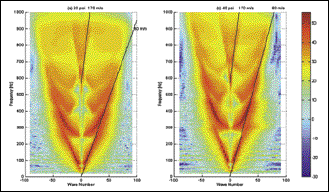Laser Vibrometer on Track Toward a Quieter Highway
Daniel C. McCarthyMost citizens welcome the boost to local business that comes with a new or an expanded highway system, but few want traffic flowing anywhere near their back yards. Sound barriers erected along roadsides cost as much as $1 million per mile and reduce noise only for the nearest houses. For residents a block or two away, it's as though the wall isn't even there. Thus, noise pollution from highways has been a source of public contention at many town meetings, but officials have been able to offer few solutions.

A computer-generated, color-mapped image captured with laser vibrometry shows how vibrations propagate through automobile tires. The research could eventually help reduce noise pollution near highways. Courtesy of Purdue University.
Researchers at the newly established Institute for Safe, Quiet and Durable Highways at Purdue University hope to find solutions using a laser vibrometer from Polytec PI Inc. So far, work has focused on one theoretical source of road noise: tire carcass vibration. "Vibration of the tire carcass can radiate sound the way a speaker radiates sound," explained Bob Bernhard, co-director of the institute.
The researchers are using laser Doppler vibrometry with an electro-magnetic shaker, which sends vibrations of various intensities through a tire. Reflected light from a helium-neon laser records how these vibrations propagate as interferograms.
"It's like dropping a pebble in a lake and watching how the ripples move away," explained Bernhard. "We study which waves propagate more than others, what radiates sound and what doesn't."
Polytec's device will measure vibrations propagating at speeds from 1026 m/s to 10 m/s with rates between 1 Hz and 1 MHz. But more than precision, what the researchers needed was a noncontact method of measurement that allowed them to scan the surface of the tire without touching it. Polytec's laser vibrometer came with a fiber optic probe that allowed the team to make measurements easily from any angle, whether the tire was rotating or stationary. "Once we understand how these waves propagate through a tire, then it's a matter of determining how to control the sound radiation," Bernhard said.
LATEST NEWS
- AmeriCOM Adds President and CEO: People in the News: 5/1/24 May 1, 2024
- Machine Learning Pushes High-Power Lasing Limits May 1, 2024
- IPG Names Industry Veteran Mark Gitin CEO Apr 30, 2024
- 16th Biannual Optatec Conference Continues in Frankfurt Apr 30, 2024
- Celestial Surface Mapping Tech Combines Established Techniques Apr 30, 2024
- TSMC Partnerships Target Integrated Photonics Capabilities Apr 30, 2024
- CLEO Heads to the East Coast Apr 29, 2024
- Qubits Could be Stored in Flash-Like Memory Apr 29, 2024
